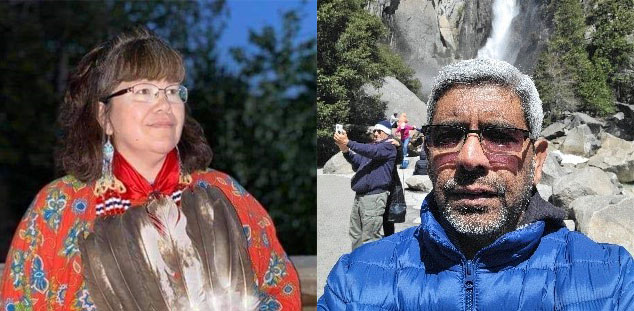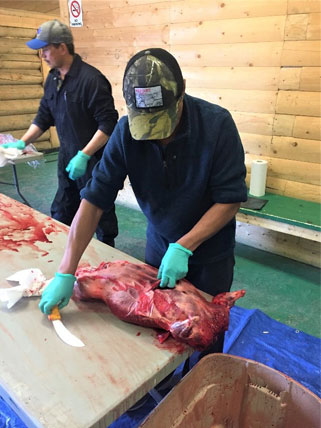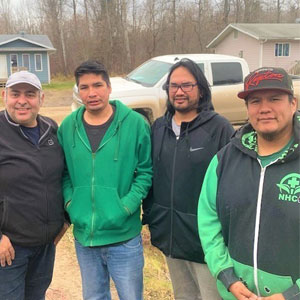First Nations Environmental Contaminants Program: Successful outcomes and positive impacts from community-based projects
First Nations communities are monitoring and investigating environmental contaminants to increase awareness of potential health hazards and to improve environmental conditions.
Six communities have shared their experiences conducting this research with support from First Nations Environmental Contaminants Program (FNECP).
Mohawk Council of Kanesatake’s Environmental Contaminants Health and Impact Project

Photo courtesy of Isabelle-Anne Bisson, TerraHumana Solutions. Valerie Gabriel (left) and Tianai Zhou (right) collect water samples from a nearby stream in one of the priority areas identified by Kanesatake community members.
For over 50 years, the land of Kanesatake has been used as a cheap and unregulated waste dumping site. Since then, community members have complained about the potential hazards that unregulated waste may pose to their health. They have long feared that these presumed contaminated waste products are linked to the serious illnesses such as cancer, which are more commonly reported in the community, especially from their Elders who have cited as a relatively new phenomenon.
In August 2019, thanks to funding received from FNECP, the Mohawk Council of Kanesatake launched the first study on environmental contaminants and their potential impacts on the health of community members in Kanesatake.
The council launched the community-driven Kanesatake Environmental Contaminants Health and Impact Project (ECHIP) with the Ratihontsanonhstats Kanesatake Environment and its collaborators, including:
- Dr. Isabelle-Anne Bisson, TerraHumana Solutions
- Dr. Niladri Basu, McGill University’s Center for Indigenous Peoples’ Nutrition and Environment (CINE)
The project team members developed a sampling protocol, trained 4 community members on environmental sample collection following the protocol, and selected priority areas for sampling. Training was conducted under their academic partner’s, Dr. Niladri Basu, supervision. Sampling of approximately 100 sites in Kanesatake included soil, water (from wells and natural sources) and plants - both medicinal and food (at farms, home gardens, and communal land).
Samples were tested for heavy metal concentrations. In this first leg of the project, heavy metals over the regulatory limits were detected in several sites.
"Our goal was to gain knowledge and identify the potential health risks related to the potential presence of environmental contaminants in the soil and plants - specifically when harvested for medicinal purposes, and cultivated for food – as well as our water," said Eugene Nicholas, Environmental project manager at the Mohawk Council of Kanesatake. He added that, "Because this was the first study of its kind in Kanesatake, a significant amount of capacity building and organization was required, including the optimization of the Ratishontsanonhstats Kanesatake Environment, as well as equipment necessary for field and sample storage. Through the FNECP funding, we also launched the very first Human Health Risk Assessment and discovered that the community is unique in the foods that we value and eat."
Project team members:
- Eugene Nicholas
- Mary Nicholas
- Gabrielle Lamouche
- Valerie Gabriel
- Isabelle-Anne Bisson
- Niladri Basu
Dietary exposure of Maliseet First Nations in New Brunswick to chemical contaminants due to consumption of traditional food

Photos: (Left) Patricia Saulis, Executive Director and Project lead, Maliseet Nation Conservation Council; and (Right) Dr. Aruna Jayawardane, Science Director, Maliseet Nation Conservation Council
Maliseet Nation Conservation Council (MNCC) has been working with the FNECP since 2010. With help from the program they tested traditional Indigenous food such as fiddleheads, moose meat and liver, deer meat and speckled trout for the presence of heavy metals Arsenic, cadmium, nickel and mercury.
These studies have been instrumental to identify Maliseet communities at risk and the sources of contamination within the Wolastoq watershed.
In 2020, funding from FNECP helped to evaluate traditional food consumption patterns, measure contaminant levels in traditional food, and to identify communities at risk of contamination.
Tobique and Woodstock First Nations participated at the study and MNCC tested their traditional food such as smallmouth bass, striped bass, speckled trout and brown trout for:
- Endosulfan I and II Total PCBs (polychlorinated biphenyls)
- Decachlorobiphenyl
- Glyphosate
- Arsenic
- Cadmium
- Nickel
- Mercury
Slightly higher levels of decachlorobiphenyl and heavy metals were detected in the fish samples collected from Tobique and Woodstock First Nations and these two communities were identified at risk of contamination.
A study will be conducted in the summer to collect food consumption data in Woodstock and Tobique First Nations to identify sources of contamination in the watershed.
"Funding from FNECP has been very useful to evaluate traditional Indigenous food for environmental contaminants and to identify First Nation communities at risk," said Dr. Aruna Jayawardane, Science Director for the Maliseet Nation Conservation Council. "Over the years, FNECP has made a substantial contribution to improve the health of Indigenous Peoples in Canada."
Project team members:
- Patricia Saulis
- Aruna Jayawardane
- Anne Cremazy
- Michelle Gray
- Bethany Reinhart
Assessment of beaver tissue quality in the traditional territory of the Chipewyan Prairie Déné First Nation

Photo courtesy of Ave Dersh. (Left) Stuart Janvier, community coordinator, and Keith Black (trapper) prepare beaver samples for analysis.
Situated in the Athabasca Oil Sands region, the Chipewyan Prairie Déné First Nation (CPDFN) is concerned about how industrial activities might impact the quality of their traditional food. Beaver (tsá) is an important traditional food for members of the Chipewyan Prairie Déné First Nation. The FNECP provided the community with the funds needed to help answer this lasting question, "Are the beaver safe to eat?"
In 2019, they received FNECP funding to investigate metal concentrations for 19 trace metals in beaver tissues (muscle, liver and kidney), including:
- Arsenic
- Cadmium
- Lead
- Mercury
Through partnering with trappers, project members were able to harvest beaver and submit a portion of each for analysis. Five of the samples of beaver muscle were also submitted for arsenic and mercury speciation to understand the nature of those metals in the tissue.
The study involved Elders, youth, and community members in the planning and implementation. Trappers harvested 16 beaver on the Christina and Winefred Rivers, and the samples were brought to the Janvier arena and prepared for analysis. Twenty community members, trappers and others who self identified as beaver consumers, helped complete a consumption survey.
The study results showed that beaver muscle is a healthy meat choice and that the concentrations of metals in the beaver muscle tissues have stayed the same or decreased over the last 15 years.
Project team members:
- Ave Dersch, Chipewyan Prairie Déné First Nation
- Claire McAuley, Intrinsik Corp.
- Stuart Janvier, Chipewyan Prairie Déné First Nation
The Chipewyan Prairie Déné First Nation study coordinator concluded that, "The FNECP provided our community with the funds we needed to be able answer a traditional food quality question for ourselves. Through partnering with trappers we were able to harvest beaver and submit portions of each for analysis, and to answer questions raised by our community members with confidence."
Investigation of Radon Concentrations in Homes in Neqotkuk (Tobique First Nation) in New Brunswick

Photo courtesy of Deana Sappier. Reni Bear, community coordinator is featured in this photo and presented the radon project at the Neqotkuk Health Centre Community Health Fair held on May 31, 2022 to promote Neqotkuk Tobique First Nation’s services.
Neqotkuk (Tobique First Nation) received funding from the First Nations Environmental Contaminants Program to investigate radon concentrations in a random sample of 33 homes from the community. The project provided resources to mitigate houses where high levels of radon were detected. Radon detectors were placed in each of the homes for 90+ days and were purchased and analyzed through the New Brunswick Lung Association. Participation in the program was voluntary and all householders who participated completed a questionnaire about the structure of the home and its age.
In 24 homes, radon concentrations were found to measure above the Health Canada guidance values. Remediation activities were then undertaken over the summer of 2021 by a qualified community contractor and were completed by October 2021. Post remediation detectors were placed in each of the homes for another 90+ day period to confirm reduced radon concentrations.
Results of the post remediation testing identified that the activities successfully reduced the radon concentrations in all of the homes. Findings also concluded there are no apparent spatial trends in the radon concentration data, and also no clear connections between house construction date and measured radon levels.
Deana Sappier, the Senior Advisor at Tobique First Nation (Neqotkuk) and Community Project Lead, shared that, "The FNECP program helped to raise awareness about radon throughout our community through ongoing updates from the Neqotkuk health center. It also enabled the testing and remediation of the homes. The results showed the extent of radon infiltration into homes and emphasize the need for testing." Deana added that, "The results of the post remediation testing identified that remediation activities successfully reduced the radon concentrations in all of the homes."
Project team members:
- Deana Sappier
- Reni Bear
- Claire McAuley, Intrinsik Corp.
- Ave Dersch
Community-based monitoring study establishing baseline fish mercury and heavy metal concentration in the traditional territory of Naskapi Nation of Kawawachikamach

Photo courtesy of Water First. Water First Interns Lawrence Mameanskum and Kabimbetas Noah Mokoush (right) collect lake water quality data during the baseline study.
Caribou have always been an important part of Naskapi Nation of Kawawachikamach community members’ diets and traditions. However, climate change has resulted in dramatically affecting migration patterns and caribou numbers. As a result, fishing has become more important for the community members’ diets.
Through the FNECP program, community members teamed up with Water First to measure mercury and heavy metals in fish, water and sediment from the primary fishing lakes in the territory. The sampling focused on lake trout and whitefish, the main fish in local diets. A diet survey was also done with community members to learn the types of fish, as well as the amount and frequency of fish people consume, to estimate how much mercury they might be exposed to. Four members showed Water First staff the community fishing locations and learned how to collect the fish, water and sediment samples for metal analysis.
After analysing the data, Water First staff presented the results and spoke with key members of the community to discuss the results. It was found that mercury may exceed recommended dietary levels in larger lake trout. This is of special concern for children under twelve and women of child bearing age.
Whitefish contains much lower levels of mercury at all size classes, and is good to incorporate into the diet in place of larger trout. Fish is an important cultural food and an important source of protein and nutrients for community members.
"Fish is an incredibly important part of our diet, and through FNECP it was learned that instead of eating less fish, we could mix up the types of fish like brook trout and whitefish, instead of primarily lake trout," shared David Swappier, a Chief’s Councillor for Naskapi Nation. "The project taught our community about the contaminants in our fish as well as how to make slight adaptations to reduce our risk of mercury exposure. Our community members learned many new skills as part of this project, and allowed us to develop a close relationship with Water First which has led to additional projects which will benefit the community."
Project Team:
- Murray Richardson, Carleton University
- David Swappie, Councillor on the Naskapi Nation of Kawawachikamach
- Lawrence Mameanskum
- Kabimbetas Noah Mokoush
- Wayne Nattawappio
- Curtis Tootoosis
- Stella Pien
- Thomas Fortin
- Valerie Fauteux
- Jag Saini
- Ryan Osman
- Carli Lang, Water First
Assessing Indoor Exposure to Radon Gas and related Health Impacts at Red Earth Cree Nation

Photo courtesy of Red Earth Cree Nation featuring team members who helped with the installation of radon dosimeters in October 2019. From left to right: Mohamad ElRafihi, Student Researcher, Herman Garvin, dosimeter installer, Clifton Head, team leader, dosimeter installer and son of health director, and Joshua Mckay, dosimeter installer.
FNECP funding helped implement a project to assess indoor exposure to radon gas at Red Earth Cree Nation for the 2018-2019 fiscal year.
Project-related activities included:
- radon project committee meetings at the community level to inform on activities
- recruitment of community members for the deployment and collection of radon dosimeters
- radon household surveys with home occupants
- installation and collection of radon dosimeters from all private residences, public buildings and facilities in Red Earth Cree Nation.
Mohamad (Moe) Elrafihi, Student Researcher from the University of Saskatchewan, Environmental Health Supervisor, Prince Albert Grand Council concluded that, "This project was implemented following the successful partnership between the Prince Albert Grand Council, Red Earth Cree Nation and the University of Saskatchewan with the funding support from the Indigenous Services Canada’s FNECP." Moe added that, "The FNECP also provided funding to support mitigation of homes with radon levels above the Health Canada guideline, as part of intervention research."
Project team members:
- Dr. Kerry McPhedran, Principal Investigator, University of Saskatchewan.
- Mohamad ElRafihi, M.Sc. Student, University of Saskatchewan.
- Cyril Head, Health Director, Project Leader, Red Earth Cree Nation